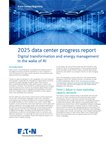Forward-thinking enterprises are gaining a competitive advantage in one unexpected area: the timing of their data center procurement.
As these enterprises search for space to power their critical workloads, they're discovering that capacity really does vanish while they deliberate. Vacancy rates in primary markets plunged to a record-low 1.9 percent last year, according to CBRE, while 80 percent of new construction is already claimed before the first server comes online.
Despite a 70 percent surge in building activity in 2024, demand continues to outstrip supply. It is set to climb 19-22 percent annually through 2030, according to McKinsey. Even if every currently planned project is completed on schedule, the US could still face a data center supply shortfall exceeding 15GW by the start of the next decade.
Major hyperscalers and technology companies are now securing capacity two or more years in advance, directly reducing availability for enterprises that lean on traditional procurement cycles. To be successful, you must respond by accelerating your internal planning processes and aligning IT infrastructure planning to match these new market realities.
The data center's terms have changed
Five years ago, the lack of encumbered capacity provided a malleable marketplace for sellers and buyers. That market dynamic has shifted significantly, and it's not temporary. By securing capacity so far in advance, hyperscalers and AI companies are fundamentally changing how space is allocated and priced. You'll increasingly face limited options if you're still operating on traditional purchasing timelines.
With occupancy rates hovering near 98 percent, successful organizations are adapting their approaches. They're focused on securing capacity when and where they need it. Understanding these new parameters — matching internal planning with market realities, identifying providers with available space and guaranteed power access, and acting decisively — will help you position yourself for success.
How to get the capacity you need today
The risk of being left on the sidelines is simply the reality of a supply-constrained market where traditional approaches no longer yield results.
Successful enterprises now begin their planning up to 24 months before needed delivery dates — and for good reason. While you're developing your 2026 forecast, providers are already inking agreements for 2027. Aligning your planning horizon with the hyperscalers and the overall market cadence helps ensure your organization doesn't miss critical opportunities.
But securing the space you need is also about moving smart. Start with a deep dive into your target markets. Which providers have guaranteed power access? When will it be available? Can you expand once you're signed on with them? This will often separate viable options from wasted time. Study recent transaction rates to understand true market pricing and thoroughly map out alternatives and their delivery timelines.
You should also challenge traditional geographic assumptions. That 60-mile radius around headquarters might be unnecessarily shrinking your options. If you want to be in Austin, would you be willing to go to Dallas? Would remote hands support make that switch viable? With strong interconnection capabilities, you can seamlessly connect to other data centers, cloud providers, and partners regardless of location. In markets where vacancy rates hover at record lows, flexibility often unlocks better solutions.
Most crucially, your internal processes must match market realities. This means engaging business units earlier to project their requirements further into the future and accelerating budget approval timelines. When your IT team assesses capacity needs 18-24 months out, and your finance department adapts its funding windows accordingly, you will be in position to act decisively should an opportunity to secure capacity arise.
Consider the parallels to purchasing a home in a competitive market: You wouldn't start looking for somewhere to live without understanding what's available and having financing in place. The same principles apply here, just on a commercial scale.
Relief is coming — but it will take time
The current supply and demand equation may not last forever. However, given ongoing supply chain constraints and the time required to bring new power online, the broader trend isn’t expected to shift until 2030. While some markets may stabilize sooner, waiting won’t serve your short- or long-term needs.
But waiting for market corrections won't address your immediate capacity needs. Your AI initiatives, customer commitments, and growth plans need support now. This means accelerating planning cycles, adjusting budget forecasts, and broadening geographic search parameters. It also means building internal systems that can identify and act on capacity requirements months or years before they become critical.
While many organizations are still adapting to these new market conditions, you can transform your approach and secure the capacity your business needs, starting with the planning decisions you make today.




